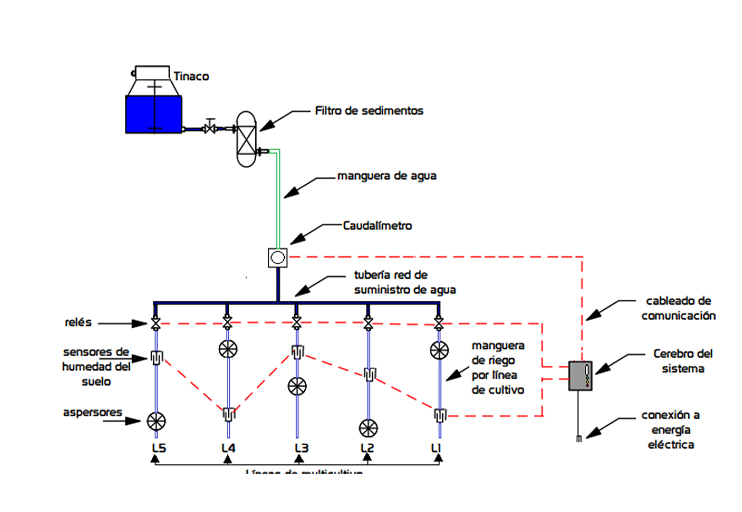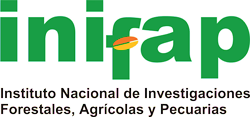Water efficiency in polycultures for small-scale agriculture
DOI:
https://doi.org/10.29312/remexca.v16i6.3821Keywords:
agricultural sustainability, automated irrigation, backyard agriculture, polycultures, precision agricultureAbstract
The adoption of irrigation technologies in small-scale crops faces economic barriers that hinder their implementation. This research developed, implemented and assessed an automated irrigation system for polyculture based on an open-source platform. In September 2023, the system was installed in the Orquiazul® greenhouse, Veracruz, Mexico, being applied to orchids of the Phalaenopsis, Dendrobium and Vanda species. Equipped with substrate moisture, temperature and relative humidity sensors and controlled with an Arduino-R1®, it automatically regulates the water supply according to the needs of each plant. Between September and December 2023, it reduced water consumption by 94%, going from 90 L biannually with manual irrigation to only 5 L with the automated system. In addition, it decreased weekly supervision from 10 to 2 h and achieved a 100% survival rate. Its modular design and low cost favor its adoption in rural communities without requiring advanced technical knowledge. Although the results are promising, it is recommended to evaluate its performance in different crops and climates to ensure its economic viability and long-term sustainability, reinforcing the potential of accessible technologies in small-scale agriculture.
Downloads
References
Akter, S.; Mahanta, P.; Mim, M. H.; Hasan, M. R.; Ahmed, R. U. and Billah, M. M. 2018. Developing a smart irrigation system using Arduino. International Journal of Research Studies in Science, Engineering and Technology. 6(1):31-39. http://www.ijrsset.org/pdfs/v6-i1/5.pdf.
Al-Hazmi, H. E.; Mohammadi, A.; Hejna, A.; Majtacz, J.; Esmaeili, A.; Habibzadeh, S.; Saeb, M. R.; Badawi, M.; Lima, E. C. and Mąkinia, J. 2023. Wastewater treatment for reuse in agriculture: Prospects and challenges. Environmental Research. 236(1):1-14. https://doi.org/10.1016/j.envres.2023.116711.
Barnes, A. P.; Soto, I.; Eory, V.; Beck, B.; Balafoutis, A.; Sánchez, B.; Vangeyte, J.; Fountas, S.; Van W. T. and Gómez, M. B. 2019. Exploring the adoption of precision agricultural technologies: a cross regional study of EU farmers. Land Use Policy. 80:163-174. https://doi.org/10.1016/j.landusepol.2018.10.004.
Brahmanand, P. S. and Singh, A. K. 2022. Precision irrigation water management-current status, scope, and challenges. Indian J. Fertil. 18:372-380. https://www.researchgate.net/publication/360119350.
Carrera, F. F.; Sánchez, H. S.; García-Orellana, Y. and Chadrina, O. 2021. A system for measuring water levels in open-air irrigation canals. In: EPJ Web of Conferences. 248:1-6. EDP Sciences. https://doi.org/10.1051/epjconf/202124802011.
CONAGUA. Comisión Nacional del Agua. 2023. Estadísticas del agua en México 2023. Ciudad de México. https://acortar.link/FrkxpX. 69-84 pp.
Da-Silveira, F.; Lermen, F. H. and Amaral, F. G. 2021. An overview of agriculture 4.0 development: systematic review of descriptions, technologies, barriers, advantages, and disadvantages. Computers and Electronics in Agriculture. 189:1-20. https://doi.org/10.1016/j.compag.2021.106405.
Dahane, A.; Benameur, R. and Kechar, B. 2022. An innovative smart and sustainable low-cost irrigation system for smallholder farmers' communities. 3rd international conference on embedded & distributed systems (EDiS). 37-42 pp. Doi:10.1109/edis57230.2022.9996498.
FAO. 2023. World Food and Agriculture. Statistical Yearbook 2023. Rome. Doi:10.4060/cc8166en. 39-45 pp.
García-Salazar, J. A.; Bautista-Mayorga, F. y Reyes-Santiago, E. 2023. Factores que condicionan la tasa de adopción de sistemas de riego tecnificados en México. Agronomía Mesoamericana. 51202-51202 pp. Doi: https://doi.org/10.15517/am.v34i2.51202.
González-Lorence, A.; Morales, C. M.; Castro-Bello, M.; Navarrete-Damián, J.; Ayala-Landeros, J. G. and Ramírez, M. S. G. 2024. Farms connect: real-time monitoring platform for poultry farms. In 2024. Argentine Conference on Electronics (CAE) IEEE. 92-98 pp. Doi: 10.1109/CAE59785.2024.10487159.
Juárez, K. R. C. and Agudelo, L. B. 2021. Towards the development of homemade urban agriculture products using the internet of things: a scalable and low-cost solution. 2nd Sustainable Cities Latin America Conference (SCLA). 1-6 pp. IEEE. Doi:10.1109/SCLA53004.2021.9540204.
Kamienski, C.; Soininen, J. P.; Taumberger, M.; Dantas, R.; Toscano, A.; Cinotti, T. S.; Maia, R. F. and Torre, A. N. 2019. Smart water management platform: iot-based precision irrigation for agriculture. Sensor. 19(2):1-20. https://doi.org/10.3390/s19020276.
Klerkx, L.; Rose, D. 2020. Dealing with the game-changing technologies of Agriculture 4.0: how do we manage diversity and responsibility in food system transition pathways? Global Food Security. 24:1-7. https://doi.org/10.1016/j.gfs.2019.100347.
Lu, Y.; Liu, M.; Li, C.; Liu, X.; Cao, C.; Li, X. and Kan, Z. 2022. Precision fertilization and irrigation: progress and applications. AgriEngineering. 4(3):626-655. https://doi.org/10.3390/agriengineering4030041.
Lucín-Álvarez, E. J. y Torres-Lima, G. A. 2023. Diseño e implementación de una estación de monitorización de parámetros ambientales y calidad de aire aplicados al cultivo de pitahaya utilizando internet de las cosas y hardware de bajo costo. Tesis para obtener el grado de ingeniero electrónico. 4-6 pp. http://dspace.ups.edu.ec/handle/123456789/26381.
Molina, M. 2022. Paso a paso. Prueba de la t de Student para muestras independientes. Revista Electrónica AnestesiaR. 14(8):3-5. https://dialnet.unirioja.es/servlet/articulo?codigo=8704951.
Pinilla, J. E. O. y Pinzón, H. Y. R. 2011. Análisis de sensibilidad de la prueba de Student para una muestra. Comunicaciones en Estadística. 4(2):121-129.
Qazi, S.; Khawaja, B. A. and Farooq, Q. U. 2022. IoT-equipped and AI-enabled next generation smart agriculture: a critical review, current challenges and future trends. LEEE Access. 10:21219-21235. Doi:10.1109/access.2022.3152544.
SIAP. 2024. Servicio de información agroalimentaria y pesquera. Comportamiento del PIB Agroalimentario al primer trimestre de 2024. 1-3 pp. https://acortar.link/cmM7Gk.
SMN. 2023. Reporte anual del clima 2023. Servicio Meteorológico Nacional de la Comisión Nacional del Agua. 31-63 pp. https://acortar.link/de2sqo.
Statista. 2024. Valor de la producción agrícola en México de 2007 a 2023. https://acortar.link/Cqg4f7.
Tapia, C. E. F. y Cevallos, K. L. F. 2021. Pruebas para comprobar la normalidad de datos en procesos productivos: Anderson-Darling, Ryan-Joiner, Shapiro-wilk y Kolmogórov-Smirnov. Societas. 23(2):83-106.

Published
How to Cite
Issue
Section
License
Copyright (c) 2025 Revista Mexicana de Ciencias Agrícolas

This work is licensed under a Creative Commons Attribution-NonCommercial 4.0 International License.
The authors who publish in Revista Mexicana de Ciencias Agrícolas accept the following conditions:
In accordance with copyright laws, Revista Mexicana de Ciencias Agrícolas recognizes and respects the authors’ moral right and ownership of property rights which will be transferred to the journal for dissemination in open access. Invariably, all the authors have to sign a letter of transfer of property rights and of originality of the article to Instituto Nacional de Investigaciones Forestales, Agrícolas y Pecuarias (INIFAP) [National Institute of Forestry, Agricultural and Livestock Research]. The author(s) must pay a fee for the reception of articles before proceeding to editorial review.
All the texts published by Revista Mexicana de Ciencias Agrícolas —with no exception— are distributed under a Creative Commons License Attribution-NonCommercial 4.0 International (CC BY-NC 4.0), which allows third parties to use the publication as long as the work’s authorship and its first publication in this journal are mentioned.
The author(s) can enter into independent and additional contractual agreements for the nonexclusive distribution of the version of the article published in Revista Mexicana de Ciencias Agrícolas (for example include it into an institutional repository or publish it in a book) as long as it is clearly and explicitly indicated that the work was published for the first time in Revista Mexicana de Ciencias Agrícolas.
For all the above, the authors shall send the Letter-transfer of Property Rights for the first publication duly filled in and signed by the author(s). This form must be sent as a PDF file to: revista_atm@yahoo.com.mx; cienciasagricola@inifap.gob.mx; remexca2017@gmail.
This work is licensed under a Creative Commons Attribution-Noncommercial 4.0 International license.


